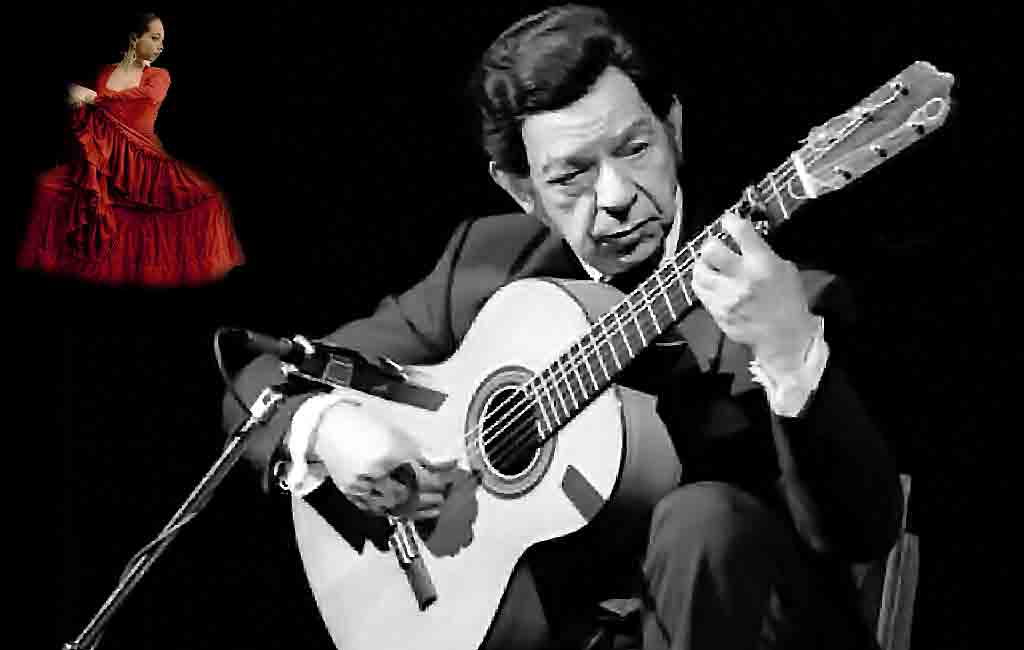Sabicas o Agustín Castellón Campos was one of the fathers of modern flamenco guitar. Although his playing style became antiquated in the fifties, we must not forget his influence on all the guitarists in the 20th century. His nickname has a really peculiar history, especially since he started playing guitar in a gypsy family when he was only 5 years old. When he was a little boy, he ate broad beans directly from his mother’s servant’s bag, when going back home from purchase. Seeing that he ate a huge quantity of fresh broad beans o Las HABAS, o en diminutive – HABICAS, so with the article, LAS-HABICAS, his mother was joking and said that he will eat LA/S-HABICAS like lunch, supper, and breakfast, she actually came with the nickname (la)S-ABICAS. So that was the reason that this nickname stuck with him his whole life…
Sabicas was born in 1912, (at the time there were no schools for flamenco, of course), so he was self-taught, like many of his contemporary colleagues… Nevertheless, he has begun his artistic career very soon. First of all, because of the impossible political situation in Spain, and fascism, there was nothing of the foreign cultural influence allowed in any case… On one side, thanks to his first gypsy cousin Ramon Montoya, who is considered to be one of the pillars of the flamenco guitar at the beginning of the 20th century. And on the other side, thanks to the Niño de Huelva, (Manuel Gomez Velez), who was also a very important artistic influencer to Sabicas as well…
Just after the first world war, he was seven years old and he performed at the Teatro Gayarre. When he was 10 years old, he was discovered by Manuel Bonet, and he moved from Provincia de Navarra to Madrid. Soon after the first world war, he started performing and did so at the “Teatro Muñoz Seca”, when he was just 10 years old.
The early period of Sabicas´s Life gained his various nicknames because that was a time of the flamenco revolution. The flamenco culture was turned inwards, with all foreign influences banned completely, because fascism wasn´t letting anything in or anything out. So all artists were turned inwards one another, which “has its good sides, too” (I know it sounds totally crazy, but it is so…)His first name, because he started playing so young was Niño Sabicas. He collaborated with many contemporary artists at the time, and because he was so young, he was considered a child prodigy.
At the times when some of the first flamenco recordings also started, besides classical music, that was on the regular recording repertoire, he collaborated with Niña de la Puebla, Juanito Valderrama, Estrellita Castro, Niña de los Peines, El Carbonerillo o Niño de la Calzá. All that gained him a status of a very advanced flamenco guitarist of the 1920’ies…
Unfortunately in 1936, Sabicas had to abandon Spain and fled over the Pirineus mountains, running away from the civil war, because “he was a lover and not a fighter”. From France, he took the boat to Argentina, and he ended up far away from Europe and its conflicted relations, that were impossible to understand and solve. Traveling to Argentina he got to know Carmen Amaya, whose family was well established in Mexico. Through that friendship, he met his wife, Esperanza González Erazo, and they lived in the city of Mexico, and with her, he had 4 kids. They both had successful careers, and one of the tours led him to New York. There he worked in the Radio City Music Hall en “telemaraton” TV format… He worked with Rosa Morena, but also with Frank Sinatra, Dean Martin, Judy Garland, Sammy Davis Junior, e t.c…
Finally, in 1967 he started to go back to Spain, and always as an honorably invited gran guitarist in the La Alcazaba, in Malaga in the 4th week of the Flamenco Studies in Malaga. There were as well participating Enrique Morente, Paco De Lucia, Serranito, Manuel Cano, and Rafael Morales, and at the end of the whole ceremony, the Malaga’s senator gave him the golden Medal of the City of Malaga. It was uniquely given to Pastora Imperio and Manolo Caracol. In New York, in the Carnegie Hall, it is considered that his last tribute is the 10th of June, 1989, where he also died, the following year, being seventy-eight years old.
Although I heard him play 14 beats instead of 12 many times, especially at the beginning of his carrier, Sabicas’s influence and presence can never be neglected. Not just because of his technical contribution to flamenco guitar in general, but because of his paving the road to the flamenco culture in America.
Flamenco Culture, being itself developed, had to find its own path and place in world music during the 20th century. That was not done with flamenco fusion, that Paco De Lucia did with John McLaughlin, Larry Coryell, and Al Di Meola. Sabicas was too respectful toward flamenco culture that he never allowed any physical mixing of the flamenco with American Jazz, for example. First because of his respect, and second because of his not knowing the Jazz harmony, and not being able to do anything really to mix the two very different musical backgrounds, Which is a very important base, first of Paco De Lucia’s, in the 1970’ies and then of my own work today. in the 21st century…

